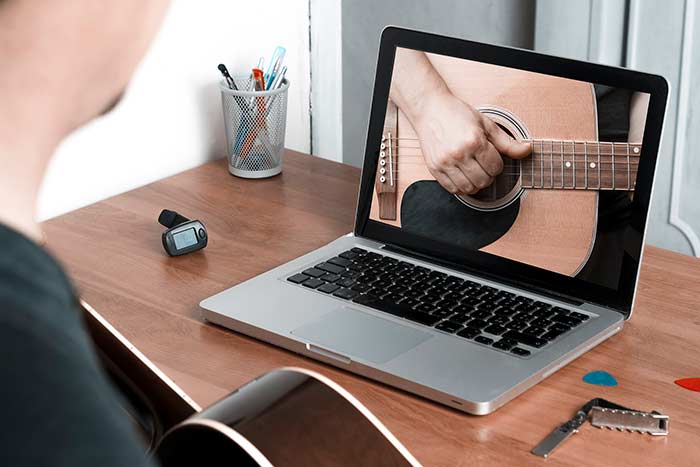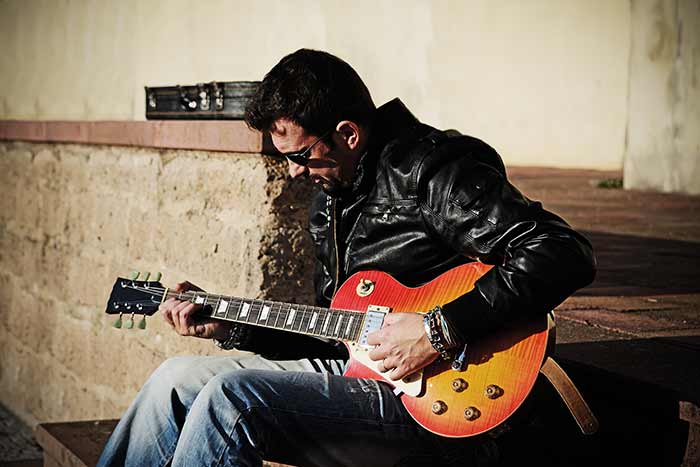Are you eager to pick up the guitar and start strumming out your favourite tunes?
Congratulations, you’ve taken the first step towards an exciting journey!
Whether you’re into melodic riffs, fiery solos, or intricate fingerpicking, learning the guitar is both fun and rewarding.
In this article, we’ll cover the basics, give you essential tips and techniques, and introduce you to inspiring artists.
With practical advice for beginners and song recommendations, you’ll be playing along in no time!
The Guitar
The guitar is a wonderfully versatile instrument that fits perfectly into numerous genres, from rock and blues to classical and jazz. Its charm lies in its ability to adapt and convey a wide range of emotions and styles.
Whether you are captivated by the electrifying sound of the electric guitar or the soothing tones of the acoustic guitar, mastering this instrument can open up a world of musical possibilities.
There are various types of guitars to explore, each offering unique characteristics:
Electric Guitar: Perfect for rock and blues, producing powerful sounds that can be amplified to create thrilling effects.
Acoustic Guitar: Ideal for folk, country, and singer-songwriter genres, delivering rich, warm tones with a natural resonance that is perfect for unplugged performances.
Classical Guitar: With its nylon strings, suited for classical and flamenco styles, offering a softer and more delicate sound.
Bass Guitar: Essential in many bands, providing the rhythmic foundation and depth in music.
With the guitar, you can effortlessly transition from strumming gentle chords to playing intricate melodies. Its adaptability makes it an ideal choice for musicians of all levels, providing endless opportunities for creativity and expression.
For a deeper dive into the various types of guitars and their unique features, check out Types of Guitars – Exploring the Diverse World of Guitars.
Choosing Your First Guitar
Choosing the right guitar is an important first step on your musical journey. Owning a guitar that suits your needs and preferences can significantly enhance your learning experience and help you stay motivated.
Here are a few tips to help you make an informed decision:
Budget
Determine how much you’re willing to spend. Beginners often opt for affordable starter kits that include the guitar, an amplifier (for electric guitars), a tuner, and other accessories. It’s important to strike a balance between quality and cost, as a well-made guitar can make learning more enjoyable.
Type of Guitar
Decide between an acoustic and an electric guitar. Acoustic guitars are ideal for beginners as they don’t require additional equipment and are great for playing a wide range of music styles. Electric guitars, on the other hand, are easier on the fingers due to their lighter strings and can be more exciting for those interested in rock, blues, or metal. Consider what type of music you want to play when making your choice.
Comfort
Ensure the guitar feels comfortable to hold and play. Visit a music store and try out a few models to find the one that suits you best. Pay attention to the guitar’s size and shape, as well as the neck’s width and length. A guitar that feels good in your hands will encourage you to practise more.
Quality
Check the build quality of the guitar. Look for any visible defects and listen for any unwanted buzzing sounds when you play. A well-constructed guitar will not only sound better but will also last longer, providing better value for your investment.
Advice from Experts
Don’t hesitate to ask for advice from experienced guitarists or staff at the music store. They can provide valuable insights and might recommend guitars that you hadn’t considered.
With the right guitar, you’ll be well on your way to enjoying the rewarding experience of learning to play.
Tips and Techniques
Starting with the basics is key to building a strong foundation on your guitar journey. Here are some essential tips to help you get started:
Holding the Guitar
Position the guitar comfortably on your left leg, with the body of the guitar resting against your body and the neck pointing upwards. Your left hand should support the neck of the guitar, allowing you to reach the fretboard with ease.
Your right hand should hold the body of the guitar or rest on its edge, depending on your playing style. Make sure the guitar is stable and at a height that feels natural for you.
Learn to Tune Your Guitar
Proper tuning is vital for ensuring your guitar sounds its best and making practice enjoyable. Invest in a good tuner and learn how to use it effectively. Regular tuning will help you develop a keen ear for pitch and improve your overall sound.
Hand Positioning
Keep your hands relaxed while playing. Place your left-hand fingers gently over the fretboard, ensuring they are slightly curled and positioned just behind the frets.
Your thumb should rest comfortably behind the neck, providing support and allowing your fingers to press down on the strings effectively.
For your right hand, whether you use your fingers or a pick, position them comfortably to strum or pluck the strings without unnecessary tension.
Master the Basic Chords
Begin by learning fundamental open chords like C, G, D, E, and A. These chords form the basis of many songs and will help you get comfortable with switching between them. As you progress, you can explore more complex chords and variations.
Fretting
To produce a clear sound, press the strings down firmly behind the frets with your left-hand fingers.
Position your fingers close to the frets but not directly on top of them, as this will help you achieve a clean note without buzzing.
Apply enough pressure to make the string sound clear, but avoid pressing too hard, which can cause strain and discomfort.
Strumming and Picking
Developing a solid strumming technique is essential for rhythm playing. Try out different strumming patterns and practise regularly.
For lead playing, focus on alternate picking to enhance your speed and accuracy. Use your right-hand fingers or a pick to strum or pluck the strings.
If using a pick, hold it between your thumb and index finger, positioning it so that it strikes the strings with a smooth, controlled motion. Experiment with different strumming patterns and picking techniques to find what feels most comfortable and produces the sound you desire.
Songs to Begin With
Starting with simple songs is a fantastic way to stay motivated and apply what you’ve learned on the guitar. Playing songs that are easy to learn helps build your confidence and reinforces the basics.
Here are a few beginner-friendly songs that are ideal for getting started:
1. “Wonderwall” by Oasis: This iconic song features a straightforward chord progression, using chords like Em, G, D, and A7. The simple strumming pattern makes it an excellent choice for beginners, and its familiar melody will keep you engaged.
2. “Knockin’ on Heaven’s Door” by Bob Dylan: This classic track uses just four basic chords: G, D, Am, and C. Its uncomplicated structure makes it easy to learn and play, allowing you to focus on mastering chord transitions and rhythm.
3. “Horse with No Name” by America: Featuring only two chords—Em and D6add9/F#—this song is perfect for beginners. The repetitive and relaxed nature of the chords makes it an approachable song to learn and play.
4. “Love Me Do” by The Beatles: This catchy tune uses simple chords like G, C, and D. It introduces you to basic chord progressions and strumming patterns, making it a great option for practising fundamental skills.
5. “Stand By Me” by Ben E. King: With its repetitive chord progression of A, F#m, D, and E, this song is an excellent choice for beginners. It helps you focus on maintaining a steady rhythm while practising chord changes.
As you become more comfortable with these tunes, you’ll find yourself progressing and gaining confidence in your playing.
Inspiring Guitarists
Drawing inspiration from accomplished guitarists can be incredibly motivating and offer valuable guidance on your musical journey.
Exploring the work of iconic players not only exposes you to different styles but also helps you understand the artistry and techniques that have shaped the guitar world.
Here are some legendary guitarists whose contributions can inspire and guide you:
Jimi Hendrix
Celebrated as one of the most innovative guitarists in history, Hendrix is renowned for his extraordinary playing style and groundbreaking use of effects.
His fusion of blues, rock, and psychedelic sounds makes him essential study material for any aspiring guitarist.
Hendrix’s improvisational flair and inventive techniques continue to inspire guitarists globally.
Eric Clapton
Known for his soulful blues playing and exceptional technique, Clapton’s music spans several decades and genres.
His expressive solos and emotional depth offer both inspiration and valuable lessons.
Clapton’s ability to convey profound emotion through his guitar is something many musicians aim to achieve.
Jimmy Page
As the legendary guitarist of Led Zeppelin, Page is famous for his intricate riffs and powerful solos.
His creative approach, including unique tunings and innovative recording methods, has made him a key figure for rock enthusiasts.
Page’s contributions have left a lasting mark on rock music.
John Mayer
Mayer’s skilful blend of pop, blues, and rock styles, combined with his adept fingerpicking, makes him a contemporary guitarist worth emulating.
His sophisticated songwriting and guitar techniques showcase a modern fusion of genres that resonates with today’s musicians.
Andrés Segovia
For those interested in classical guitar, Segovia’s impact is unmatched. His work in expanding the classical guitar repertoire and refining its techniques has greatly advanced the instrument’s role in classical music. Segovia’s dedication has inspired many classical guitarists.
These are just a few of the many inspiring guitarists whose artistry and achievements can provide you with valuable insights and motivation. As you embark on your own musical journey, their innovative styles and techniques can offer guidance and encouragement to help you develop your own unique sound.
Practising Effectively
Effective practice is essential for developing your guitar skills and becoming a proficient player.
Making the most of your practice sessions can significantly enhance your progress and keep you motivated.
Here are some key tips to maximise your practice time:
Set Clear Goals
Before each practice session, determine what you want to achieve. Whether it’s mastering a new chord, refining your strumming technique, or learning a new song, having specific objectives will help you stay focused and track your progress.
Break It Down
Structure your practise time by dividing it into different sections, such as warm-ups, chord practise, scales, and song learning. This approach ensures you cover various aspects of guitar playing and make balanced progress. 3. Record Yourself Recording your practise sessions allows you to review your playing and identify areas for improvement. Listening to these recordings helps you track your development and make necessary adjustments.
Play Along with Tracks
Using backing tracks or playing along with songs can improve your timing and rhythm. This technique helps you get accustomed to playing with others and adds variety to your practice.
Seek Feedback
If possible, get feedback from more experienced guitarists or take guitar lessons. Constructive criticism can provide valuable insights and ensure you’re progressing correctly.
Listen to Other Guitarists
Take the time to listen to recordings of your favourite guitarists to expand your musical horizons and develop your ear for different styles. By studying their techniques, you can gain inspiration and learn new methods to incorporate into your own playing. Pay attention to their use of tone, timing, and expression to better understand the subtleties of guitar performance.
Experiment with Different Genres
Don’t hesitate to explore various genres and styles of music to discover what resonates with you. Whether it’s rock, blues, jazz, or classical, experimenting with different genres can help you find your unique sound and keep your practice sessions exciting. Each style offers its own set of techniques and challenges, which can enhance your overall guitar skills and musical versatility.
Use a Metronome
Keeping time is fundamental for developing a good sense of rhythm. Practising with a metronome will help you stay on beat and improve your timing. Start at a slower tempo and gradually increase the speed as you become more comfortable.
Be Patient and Persistent
Learning the guitar takes time and dedication. Regular practice, even if it’s just 15-30 minutes a day, will lead to noticeable progress. Be patient with yourself and stay persistent; improvement will come with consistent effort.
By applying these strategies, you’ll use your practice time more effectively, address different skills, and continue to grow as a guitarist.
Join a Community
Being part of a guitar community can greatly enhance your learning experience and provide invaluable support.
Engaging with other guitarists can offer new insights, motivation, and opportunities for growth.
Here are some effective ways to connect with fellow musicians:
Online Forums and Groups
Websites such as Reddit and Ultimate Guitar host vibrant communities where you can ask questions, share your progress, and seek advice.
These platforms allow you to connect with guitarists from around the world, exchange tips, and discuss various techniques and styles.
Local Music Stores
Many music stores offer group classes or host regular jam sessions, providing a fantastic opportunity to meet and play with other guitarists. These in-person gatherings can help you build local connections, learn from others, and enjoy a sense of community within your area.
Social Media
Platforms like Facebook and Instagram feature numerous groups and pages dedicated to guitar enthusiasts. Joining these communities allows you to interact with fellow musicians, share your achievements, and stay updated on guitar-related news and events. Social media can be a great way to engage with a broader network of guitarists and find inspiration.
By exploring these avenues, you can immerse yourself in a supportive and engaging guitar community, which will enrich your learning experience and provide ongoing encouragement throughout your musical journey.
Wrapping Up Your Guitar Journey
So, You Want to be a Guitarist?
By choosing the right guitar, mastering basic techniques, practising effectively, and drawing inspiration from iconic guitarists, you’ll be well on your way to achieving your musical goals.
Remember, every great guitarist started as a beginner, and with dedication, you, too, can make your mark in the world of music.
So pick up that guitar, start strumming, and let your musical adventure begin!















